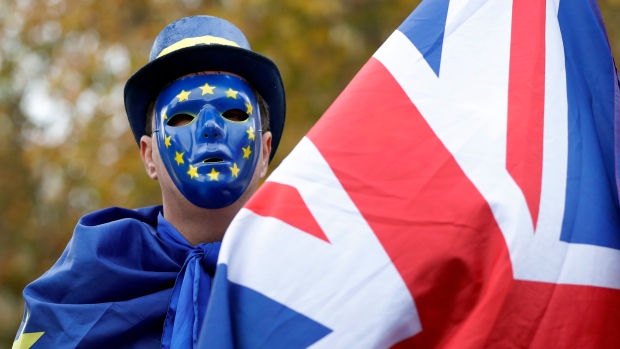Sep 11, 2018
U.K. and EU said to plan special summit to sign Brexit deal
, Bloomberg News

The U.K. and the European Union are preparing for a special summit to sign the Brexit deal in November and the meeting could be announced within days, according to people familiar with the matter.
While negotiators still need to resolve key disagreements, the EU is getting ready to schedule a one-off gathering in mid-November so leaders can formally agree to the terms of the divorce, the people said.
Despite the more positive atmosphere surrounding the talks, U.K. Prime Minister Theresa May is facing a renewed threat from inside her own party.
Pro-Brexit Tories are said to have spent several hours plotting to oust her Tuesday night because they think she’s betraying their vision of a clean break from the EU. People familiar with the matter said the meeting -- attended by about 50 Tories -- openly discussed how May could most easily be removed from office.
‘We Are Confident’
May will present her case to her EU counterparts at an informal meeting in Salzburg next Wednesday, before the other 27 leaders discuss how to respond among themselves. The plan for a special Brexit deal summit is likely to be unveiled during the course of the Salzburg gathering, two people said, with one suggesting the announcement could come even sooner.
“We are working on a deal which will be good for U.K. industry and we are confident we’re going to achieve that,” a spokesman for May’s government said Tuesday.
Scheduling a summit to conclude the withdrawal negotiations would be a sign of growing confidence among the governments of Europe that an agreement on the U.K.’s exit is close. In recent days the pound has risen on more positive news of the prospects for reaching a settlement, after falling during the summer over fears that the negotiations are at risk of breaking down. The U.K. will leave the EU, with or without a deal, on March 29 next year.
The biggest obstacle still to be resolved in the talks is the question of how to avoid customs checks and police at the border between Northern Ireland and the Irish Republic, once the U.K. has left the bloc. This is seen as critical by both sides, but talks have been deadlocked for months.
The EU’s chief Brexit negotiator, Michel Barnier, has sounded more hopeful of resolving the issue, offering to be flexible in his approach to agreeing the so-called backstop plan to avoid a hard border. Officials have detected some progress recently in talks on the backstop although the two sides remain far from finalizing a plan, according to one person.
One of the people said the special Brexit summit was being lined up for the week of Nov. 12.
On Monday, Barnier said he thought reaching an agreement on the terms of the U.K.’s departure was “realistic” within the next six to eight weeks. “I think it’s possible” to get a deal by the start of November, Barnier said at a conference in Bled, Slovenia. “We are not far from agreement.”
Once a deal is reached, it has to go to the U.K. Parliament and the European Parliament for approval. British politicians inside May’s governing Tory party, as well as in the opposition Labour Party, are preparing to sabotage the agreement.
On Tuesday, the European Research Group of euroskeptic Conservatives met in London for their regular weekly discussion. This time, one subject dominated: how to get rid of May. According to two people familiar with the meeting, nobody spoke against the idea that she must be removed.
May has made herself unpopular among pro-Brexit Tories by proposing to keep close to the EU single market for trade in goods, even after the U.K. leaves the bloc. Many ERG members want a more decisive break and oppose May’s so-called Chequers blueprint for a soft Brexit. One of those present said opposition to her leadership has hardened over the summer.
May’s soft Brexit platform sparked the resignations of her Brexit Secretary David Davis and Foreign Secretary Boris Johnson, who quit the cabinet in protest in July. On Wednesday, the ERG will put forward its own plan for resolving the Irish border question.

